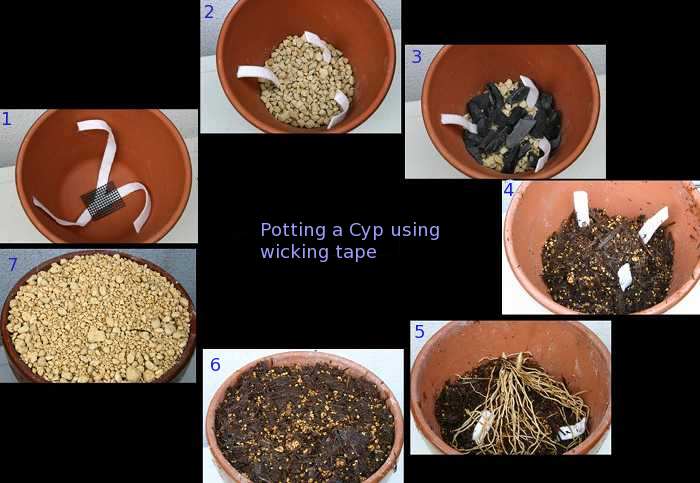LONG response (sorry)
Gosh folks, I could write a book about this. This technique is offered as a relatively simple, low-tech, and yet effect method to keep pots cool enough to grow Cyps where you have no business trying to do so. I'm sure lots of other plants could be grown this way.
David,
Yes, I repot every winter when the plants are in full dormancy. It is necessary in this climate since older roots are stressed badly and tend to die quicker than they should. Under cooler conditions this is OK since the dying tissues will simply compost into the growing medium. In the heat here they tend to simply harbor disease - bacteria and fungi - and have to be removed.
The plants are in the shade all summer, but very bright shade, under azaleas and tucking amongst ferns. I have no choice but to keep the plants out of the sun and away from concrete structures (they radiate heat throughout the night and tend to dry the air). When I first starting trying this technique the plants were grown in more controlled conditions - under a covered porch with a fan blowing on the pots to increase evaporation. The plants did OK, but suffered once the true heat of summer hit in August. So I put them under the shrubs the next year and they did much better.
Linus,
Indeed there are less difficult ways of doing this idea, and more strenuous too. I've used the sphagnum method to grow seedlings of C. macranthos in a plastic pot for a few seasons and it seemed to work OK. Humidity isn't usually a problem here (averaging above 70% most of the time), however near hot walls sphagnum works wonders for small plants.
The purpose of the two clay pots is to get the inner pot to wick water outwards, thus cooling the medium. Plastic of course doesn't allow this. In a true "zeer refrigerator" set up there would be moist sand between the inner and outer pot, increasing the evaporation much more. I started to try this technique as well, but honestly ran out of patience since it required maintaining water constantly in the outer pot, made it a pain to water the plant, etc., so I gave up. I can't say that a plastic pot would be worse or better, though it would probably cause problems during heavy rains, since pots could remain truly water logged. The summer monsoon in Japan is intense.
This year I may try putting sphagnum between the inner and outer pots to get even more wicking power from the inner to the outer pot surface. The idea is to maximize circulation of water through the system, and the added sphagnum might just do that. That will require a slightly larger outer pot for the sphagnum, and longer tape at the base to reach the water reservoir. The Cryptomoss also is a wicking material, hence it as well is important to make this system work - typical composts probably would be less effective.
A note about summer time temps here - they are blistering, averaging 30-34 C (86-93 F) daily without a break and only going down to 25 C (77 F) at night from mid July through September. In the worst of the heat (late July through mid August) air temperatures don't fall below 27-28 C (80 F+) ever, and day time highs are commonly 35 C (95 F) or more. Now you can see why I have to find a way to keep these poor plants from cooking to death!
Note about winter temperatures here - using the USDA cold hardiness zone scale I live in zone 9b, but in truth winters here are more in line with Atlanta, Georgia rather than Daytona Beach, Florida. The reason is we don't get the extreme cold events of Atlanta, however the average temperatures are in line with more northernly climates. So winters here are just barely cold enough to vernalize Cyps. For that reason I leave them out all winter in the shade.








